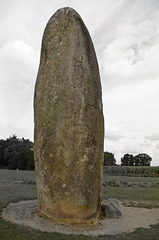John Sheldon's photos with the keyword: Dol
Gare de Dol de Bretagne
Gare de Dol de Bretagne
Gare de Dol de Bretagne
Gare de Dol de Bretagne
French Local Train at Gare de Dol de Bretagne
| 12 Oct 2021 |
|
|
|
A DMU (diesel multiple unit) SNCF 73574 serves the Breizh / Bretagne region. A small local French train waiting in the station at Dol, Brittany.
Gare de Dol de Bretagne
Menhir de Champ-Dolent
| 27 Apr 2021 |
|
|
|
Menhir of the 'Field of Woe'.
Original 'normally coloured' DNG manipulated using Adobe Lightroom 3.
Currently the largest standing stone in France. An easy walk from Dol de Bretagne.
The Menhir stands 9.5m high with an estimated weight of 150 tons.
According to legend, the menhir fell from the skies to separate two feuding brothers who were on the point of killing each other. This legend is said to account for the name "Champ Dolent" which means "Field of Sorrow". In reality, the word dolent is more likely to derive from Breton ‘dolenn’ ("meadow").
Another legend states that the menhir is slowly sinking into the ground, and the world will end when it disappears altogether.
It is not precisely dated, but recent scholarship suggests that Brittany's menhirs were erected c. 5000–4000 BC.
Examining the Menhir de Champ-Dolent
| 27 Apr 2021 |
|
|
|
Menhir of the 'Field of Woe'.
Currently the largest standing stone in France. An easy walk from Dol de Bretagne.
The Menhir stands 9.5m high with an estimated weight of 150 tons.
According to legend, the menhir fell from the skies to separate two feuding brothers who were on the point of killing each other. This legend is said to account for the name "Champ Dolent" which means "Field of Sorrow". In reality, the word dolent is more likely to derive from Breton ‘dolenn’ ("meadow").
Another legend states that the menhir is slowly sinking into the ground, and the world will end when it disappears altogether.
It is not precisely dated, but recent scholarship suggests that Brittany's menhirs were erected c. 5000–4000 BC.
François-René, vicomte de Chateaubriand
Tower fortifications at Dol de Bretagne
| 07 Apr 2021 |
|
|
|
Part of the ancient town defences at Dol in Brittany. William Duke of Normandy and Duke Harold of England attacked Conan Duke of Britany at Dol, according to the images on the Bayeaux Tapestry.
Tumble-down roof, in Dol de Bretagne
St Michel Slays the Dragon at Dol de Bretagne
| 07 Apr 2021 |
|
|
|
...and make a gesture with his left hand like a footballer who has scored a goal.
Not enough depth of field, but I like the lighting.
Cathédrale Saint-Samson de Dol de Bretagne.
Jump to top
RSS feed- John Sheldon's latest photos with "Dol" - Photos
- ipernity © 2007-2025
- Help & Contact
|
Club news
|
About ipernity
|
History |
ipernity Club & Prices |
Guide of good conduct
Donate | Group guidelines | Privacy policy | Terms of use | Statutes | In memoria -
Facebook
Twitter












